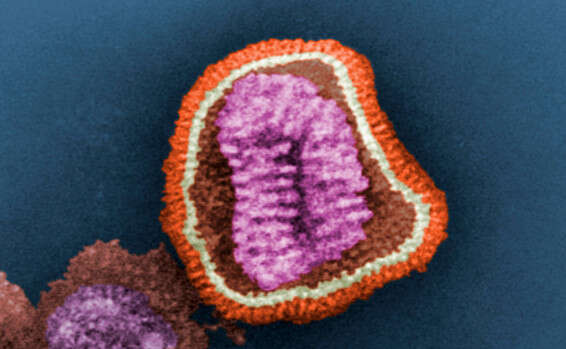A molecule called "Arnsept" developed at the Weizmann Institute, in collaboration with a number of research bodies around the world, will block animal viruses from humans to humans.
Influenza influenza virus in an electronic microscope // Photo: Reuters
Scientists at the Weizmann Institute of Science have developed a molecule that effectively neutralizes deadly viruses that pass from animals to humans.
In a previous study in Dr. Ron Diskin's laboratory from the Department of Structural Biology at the Institute, researchers compared viruses that were able to pass on humans and other non-human-infected viruses.
The researchers found that non-human viruses carry proteins that are not suitable for binding to the receptor used as a viral entry point for human cells. Surprisingly, though, even when the dangerous viruses do not perfectly match the human receptor, their partial adaptation is sufficient for them to penetrate.
Partial matching gave rise to the idea of developing a seduction molecule: to use rodent receptor receptors that fitted as a glove next to the viral entry proteins to entice and trap the viruses and keep them away from human cells.
"Previous attempts to develop such 'sticky' traps, namely molecules designed to attract viral proteins, were based on human receptors," explains Dr. Diskin. "The fact that these receptors were identical to the receptors they were supposed to compete prevented them from showing real competition."
Stopped Hunin and Macho
The researchers hypothesized that a rodent-based receptor molecule could be a significant competition for human receptors. In "surgical" action at the cellular level, Dr. Hadas Cohen-Honey removed the rodent receptor tip, assembled it on an antibody - and created a new molecule called "Arnsept." The group began testing this molecule against pseudo-virus-like engineered viruses At this stage, in collaboration with Dr. Vered Pedler-Krawani's research group at Tel Aviv University, researchers saw that the graft molecule was tightly linked to the mock viruses and also recruited the immune system to attack the viral invasion.
The next stages of the study were conducted at laboratories at the University of Texas, Galveston, USA and at the Pasteur Institute, Lyon, France, where experiments can be conducted at the highest levels of safety. In these laboratories, the harpoon was first confronted with the viruses Henin and Macopo. That have been able to bind to human receptors and have also been shown to activate the immune response.
All the signs indicate that transept is non-toxic and can withstand high temperatures, so it can be sent to the hot areas where these diseases are a danger. Scientists also believe that the idea of creating "honey traps" from mammalian receptors may be applied to a variety of other diseases that pass from animals to humans.
Knowledge, the Weizmann Institute of Science's intellectual property commercialization arm, which promotes industrial and medical applications based on the inventions of the institute's scientists, has patented the method, and is currently exploring options for developing harnesses as human health care.
Dr. Aliza Bornstein-Katz from the Weizmann Institute of Science also participated in the study; Dr. Ron Amon of Tel Aviv University; Crystal Agnes, Robert Cross and Professor Thomas Geisbert of the University of Texas, and Dr. Mathieu Matteo and Professor Sylvain Baise of the Pasteur Institute.









